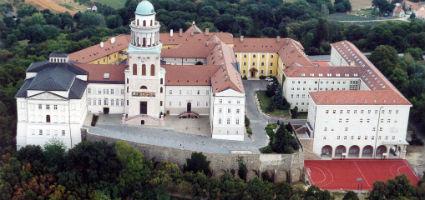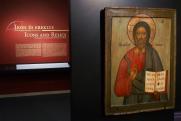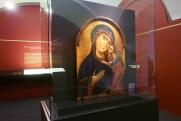 |
Address: 9090, Pannonhalma Vár 1.
Phone number: (96) 570-191, (96) 570-100
E-mail: info@osb.hu
Opening hours: 02.01-20.03.: Tue-Sun 10-15
22.03-30-04.: Tue-Sun 9-16 01.05-31.05.: Mon-Sun 9-16 01.06-30.09.: Mon-Sun 9-17 01.10-11.11.: Tue-Sun 9-16 12.11-31.12.: Tue-Sun 10-15 |
|
Ticket for traveler
|
700 HUF
|
|
|
Ticket
|
1800 HUF
|
|
|
Ticket
(shortened, only during liturgical occasions)
|
1000 HUF
|
|
|
Ticket for pensioners
|
850 HUF
|
|
|
Ticket for pensioners
(shortened, only during liturgical occasions)
|
500 HUF
|
|
|
Ticket for families
|
3900 HUF
|
/ family
|
|
Ticket for families
(shortened, only during liturgical occasions)
|
2100 HUF
|
/ family
|
|
Ticket
|
2500 HUF
|
|
|
Ticket
(shortened, only during liturgical occasions)
|
1800 HUF
|
|
|
Ticket for students
|
850 HUF
|
|
|
Ticket for students
|
1500 HUF
|
|
|
Ticket for students
(shortened, only during liturgical occasions)
|
500 HUF
|
|
|
Ticket for students
(shortened, only during liturgical occasions)
|
1200 HUF
|
|
|
Ticket for families
|
6300 HUF
|
/ family
|
|
Ticket for families
(shortened, only during liturgical occasions)
|
3500 HUF
|
/ family
|
|
Ticket for traveler
|
1500 HUF
|
|
|
Group guide
(for less than 10 people, besides scheduled times)
|
15000 HUF
|
|
|
Group guide
(for less than 10 people, besides scheduled times, short - only during liturgical occasions)
|
8000 HUF
|
|
|
Group guide
(for less than 10 people, besides scheduled times)
|
20000 HUF
|
|
|
Group guide
(for less than 10 people, besides scheduled times, short - only during liturgical occasions)
|
10000 HUF
|
The two temporary exhibitions at the Pannonhalma Archabbey this year presents little known elements related to the complex relationship of Greek and Latin Christendom images through the medium of the icon, the relic and panels
The exhibits represent extraordinary value both from a historical and art historical point of view. The exhibition is also made special due to the unique combination of items of which many have never been shown in Hungary.
Of the icons displayed, the most prominent is the 13th-century Mary - icon from the Zadar (Croatia) Church Art Exhibition. In addition, the visitors can see a 15th-century icon of the Virgin Mary from the Museum of Fine Arts (Budapest) and an 18th-century icon of the Saviour from the Serbian Ecclesiastical Museum (Szentendre). Two 17-century Deesis icons will be presented from the Pannonhalma Archabbey collection.
The exhibition is includes three relics. The 13th-century head reliquary from a Benedictine Abbey from is an internationally acclaimed item, bot from historical (possible Hungarian - Székesfehérvár relations) and aesthetic (suggestive profiles) aspects. A 14th-century St. John the Baptist hand reliquary from the Zadar (Croatia) Church Art Exhibition and a Mary Magdalene reliquary bust dated to 1332 is to be presented.
The exhibition ends with a documentary by Dénes Nagy, which invites the visitors to two medieval site in Burgundy (France), to the cathedral Vézelay where Mary Magdalene relics is kept. The the journey continues in the the Romanian Orthodox monastery in Bukovina Sucevita (Romania), which is famous of its church painted the on the outside and inside as well. The film looks at the lives of two monastic monastic community and through them different worlds' strong atmospheres outline with their colors, lights, silence and their relationship to the sacred objects.
The aim of the exhibition is to confront the visitors with the history of Greek and Latin respect of images, which is particularly important from religious history as well as art historical point of view. Questions related to religious history on image respect are important elements of Christian denominations. Transformation of religious cult images into art has turned in the last decades a central issue of science and art historical researches.


